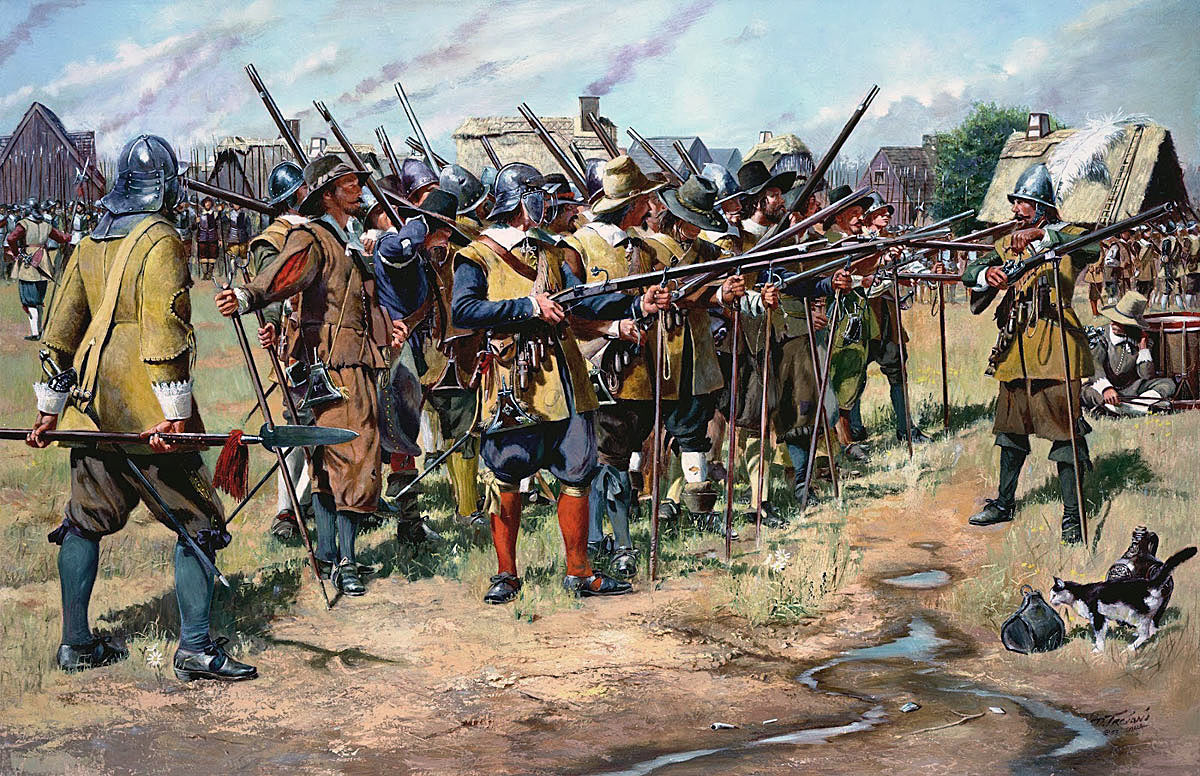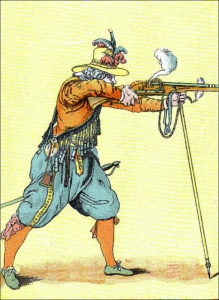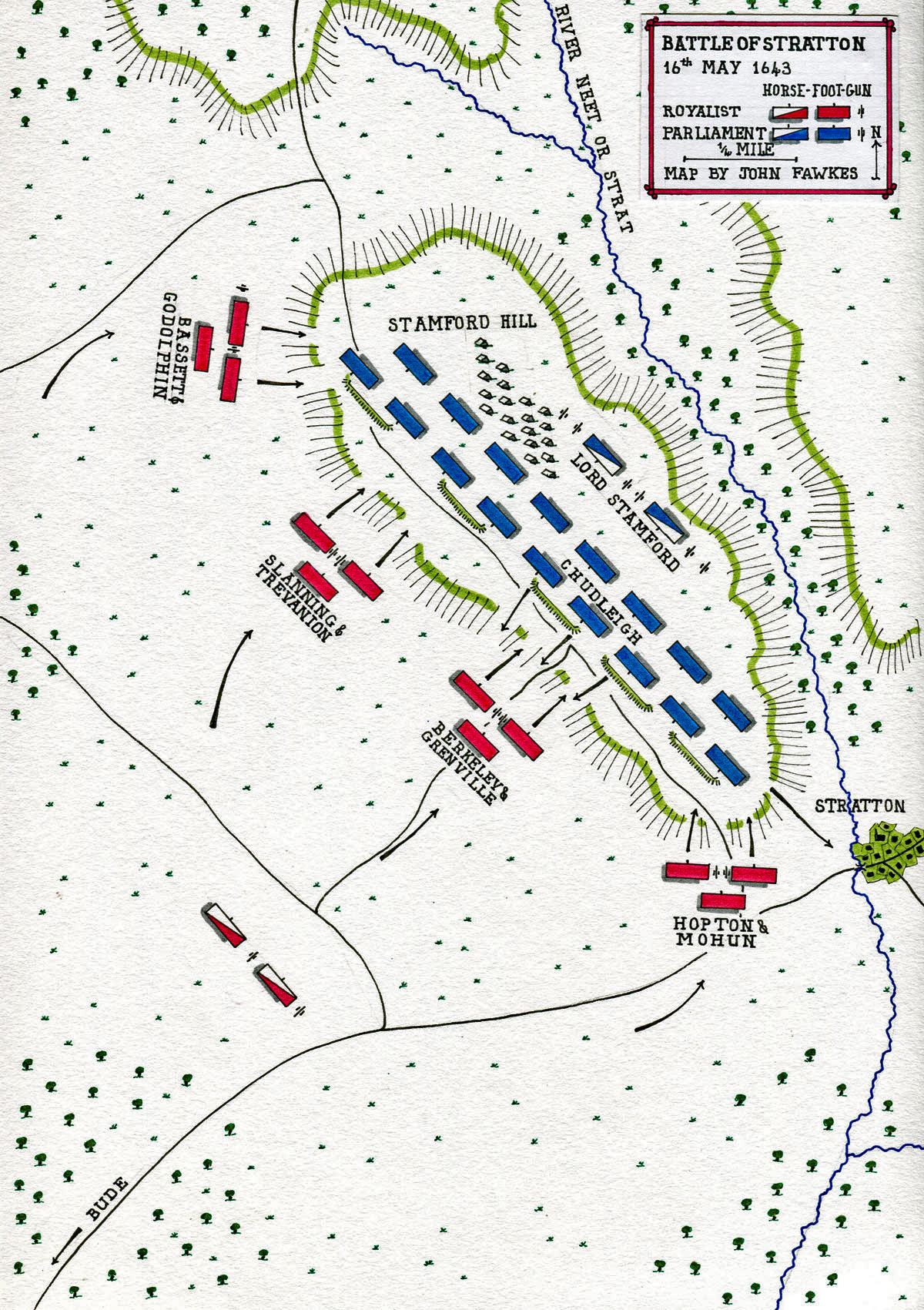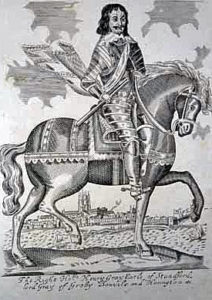A decisive Royalist victory in Cornwall, fought on 16th May 1643
The previous battle in the English Civil War is the Battle of Seacroft Moor
The next battle in the English Civil War is the Battle of Wakefield
To the English Civil War index
Battle: Stratton
War: English Civil War
Date of the Battle of Stratton: 16th May 1643
Place of the Battle of Stratton: Stamford Hill to the east of Bude on the north Cornwall coast.
Combatants at the Battle of Stratton:
The Royalist Cornish forces of King Charles I against the forces of Parliament primarily from Devon, Dorset and Somerset.
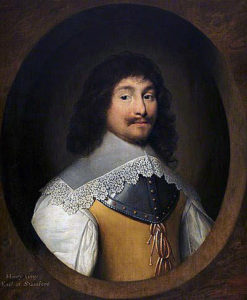
Henry Grey, 1st Earl of Stamford, Parliamentary commander at the Battle of Stratton on 16th May 1643
Generals at the Battle of Stratton: Sir Ralph Hopton commanded the Royalist army.
Henry Grey, Lord Stamford commanded the Parliamentary army.
Size of the armies at the Battle of Stratton:
The Royalist army comprised 2,400 foot, 500 horse and dragoons and some 8 guns.
Lord Stamford’s Parliamentary army comprised 5,400 foot, around 1,500 horse and dragoons and a number of guns.
Before the battle Sir George Chudleigh was sent with most of the Parliamentary horse and dragoons to the Cornish county town of Bodmin, leaving Lord Stamford with the foot, guns and a small force of horse.
Winner of the Battle of Stratton: The Royalist army.
Uniforms, arms and equipment at the Battle of Stratton:
See this section in the Battle of Edgehill.
Background to the Battle of Stratton:
The origins of the English Civil War are dealt with under this section in the Battle of Edgehill.
After unsuccessful attacks on Devon by the Royalists from Cornwall in 1642 and in early 1643 a truce was negotiated between the two sides in Cornwall and Devon from mid-February to April 1643.
On Sunday 23rd April 1643 with the expiry of the truce the Parliamentary forces in Devon began an attack on Cornwall.
After the defeat of Sir Ralph Hopton’s Royalist army by James Chudleigh at Sourton Down on 25th April 1643 Lord Stamford on 15th May advanced from Okehampton to the north coast. Picking up re-inforcements and crossing the River Tamar into Cornwall Lord Stamford marched to Stratton, inland from Bude, where he established a camp on what came to be called Stamford Hill.
While the Parliamentary foot built field works along the summit of the Stamford Hill ridge, Sir George Chudleigh took the army’s horse and dragoons, other than a small party of around 150, and rode to Bodmin with the aim of capturing the senior Royalist dignitaries of Cornwall and disrupting the raising of the Royalist ‘posse comitatus’ in the county capital.
The mechanism of the ‘posse comitatus’ was used by both sides in different parts of the kingdom during the English Civil War. The ‘posse comitatus’ involved the summoning of all able bodied men in an area to repel an outside threat to the community. A force produced in this way was rarely of much use militarily although it was a convenient way of assembling men from whom more effective and committed regiments could be raised by calling for volunteers.
The Cornish Royalist army led by Sir Ralph Hopton marched out of Launceston to the north on 12th May 1643 to meet Stamford’s Parliamentary incursion into their county.
On Sunday 13th May 1643 the Cornish encountered Sir George Chudleigh’s force riding towards Bodmin and an extended skirmish took place, before Sir Ralph Hopton realized this was not the main Parliamentary army.
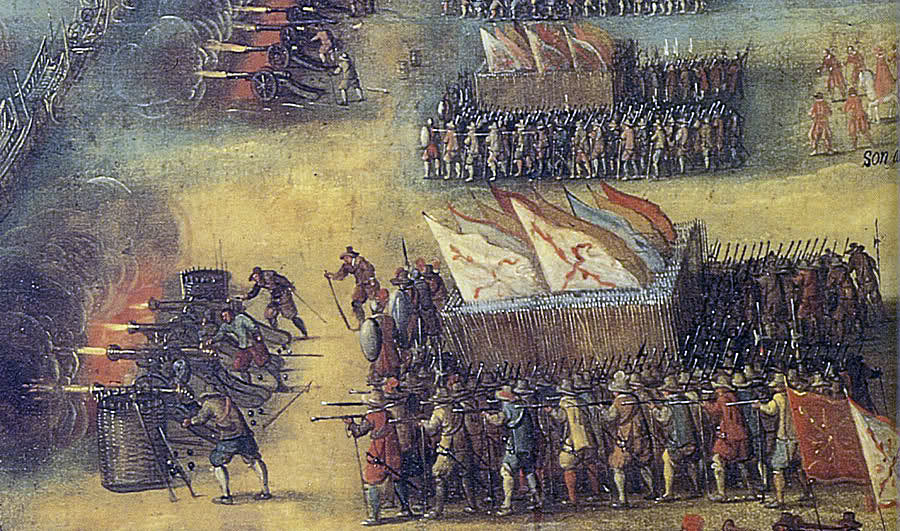
Foot and guns in battle at the time of the English Civil War: Battle of Stratton 16th May 1643 during the English Civil War
Hopton’s army reached Week St Mary the next night. A severe shortage meant only one biscuit per man, a level of rations that continued throughout the march until the end of the battle.
Between the Royalist army and the Parliamentary positions on Stamford Hill lay the River Neet or Strat (the actual name of the river) which curved round to the north and formed the eastern boundary of the Stamford Hill Ridge.
Lord Stamford posted bodies of musketeers at three of the most obvious river crossing points to a point 1 ½ miles upstream from the town of Bude. Sir Ralph Hopton marched his force up the left bank of the river to Efford House where the Royalist Forlorn Hope crossed the river and forced back the Parliamentary musketeers. Lord Stamford withdrew the musketeers remaining at the other crossing points to his camp on Stamford Hill.
With night approaching the Royalist army conducted the customary council of war and decided to attack the Parliamentary position before Sir George Chudleigh’s horse returned from Bodmin and attacked them in the rear.
During the rest of the night the Cornish foot crossed the river and moved up to the base of Stamford Hill.
Account of the Battle of Stratton:
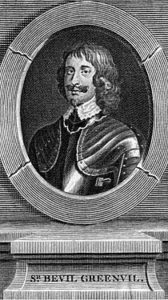
Sir Bevil Grenville, Royalist commander of an attacking columns at the Battle of Stratton on 16th May 1643 during the English Civil War
Sir Ralph Hopton resolved to deliver his attack on the Parliamentary positions at the top of Stamford Hill by way of four simultaneous assaults widely spaced along the face of the hill. Each of the four columns comprised 600 foot and 2 guns, while to the rear was the reserve of 500 horse and dragoons.
The Royalist column on the right, led by Sir Ralph Hopton and Lord Mohun, would attack the south face of Stamford Hill. The next column commanded by Sir John Berkeley and Sir Bevil Grenville and the third commanded by Sir Nicholas Slanning and Colonel Trevanion would attack the main western face of the hill, while Sir Thomas Bassett and Colonel Godolphin led the assault on the northern face of Stamford Hill.
The Parliamentary foot were dispersed in defensive positions along the top of the rectangular hill. Lord Stamford took a position towards the rear and exercised little control over his troops.
The Royalist attack up the western slopes of Stamford Hill began at 5am.
Accounts of the battle lay particular emphasis on the Berkeley/Grenville column which for that reason appears as the main component of the Royalist assault. The battle up the hillside took all day with the Royalist Cornish foot gaining ground until 3pm when Major General James Chudleigh led a stand of pike in a charge on Sir Bevil Grenville’s regiment as it advanced up the road.
Initially Chudleigh’s attack progressed with Grenville himself being knocked to the ground until Berkeley brought his musketeers to fire on the Parliamentary pikemen from the surrounding fields and more of Grenville’s men came up the road. Chudleigh’s men were driven back and he was captured by the Royalists.
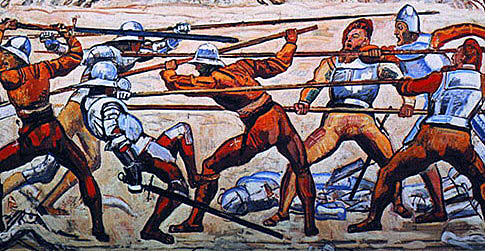
Swiss pikemen in the 16th Century, showing how the long pike was used in attack, as at the Battle of Stratton on 16th May 1643
The same pattern was repeated with the other Royalist columns, attacking in strength at particular points along the strung out Parliamentary line. Except for the initiative taken by Chudleigh against Sir Bevil Grenville there was no co-ordination or proper command exercised in the Parliamentary army, so that it was overwhelmed by a force half its size carrying out a series of concentrated attacks.
The four Royalist columns met at the centre of the hill while the Parliamentary force dispersed and fled.
Lord Stamford caused his guns to fire a final salvo before fleeing, making his way across the county boundary to Bideford in Devon and then to Exeter, leaving his guns on the battlefield for the Royalists.
Casualties at the Battle of Stratton:
The Royalists captured 13 guns and a mortar. They also took 70 barrels of powder, replenishing their near-exhausted ammunition supply, and quantities of provisions, to the delight of the famished soldiery.
Royalist dead at the battle are reported at around 90.
Parliamentary casualties are said to have been 300 dead and 1,700 taken prisoner, including James Chudleigh and a number of other officers. Probably many more Parliamentary soldiers deserted and went home which was a consequence of defeat (and sometimes of victory) during the English Civil War.
Follow-up to the Battle of Stratton:
Sir George Chudleigh received news of the battle at Bodmin which he had captured after a short resistance, dispersing the ‘posse comitatus’ and releasing 150 Parliamentary prisoners from the prison. Chudleigh precipitately abandoned his efforts to raise recruits and left Bodmin, losing many of his men to the resurgent Royalists during his hasty retreat.
After the Battle of Stratton Sir Ralph Hopton received instructions to join the Marquis of Hertford and Prince Maurice, who were marching to the West Country with an army, the rendezvous being Chard in Somerset.
Anecdotes and traditions from the Battle of Stratton:
- The 70 year old Mr Kendall, Royalist mayor of Lostwithiel, was killed in Sir George Chudleigh’s assault on Bodmin. It is said that Mr Kendall killed 10 Parliamentary troopers before being overwhelmed.
- The Battle of Stratton and his subsequent surrender of Exeter was the effective end of Lord Stamford’s career as a Parliamentary commander.
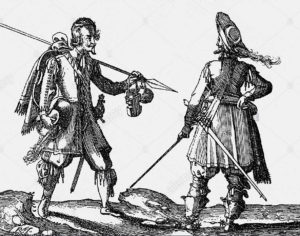
Infantry soldiers of the English Civil War: Battle of Stratton 16th May 1643 during the English Civil War
References for the Battle of Stratton:
The Battle of Stratton by Stuart Peachey
The English Civil War by Peter Young and Richard Holmes
History of the Great Rebellion by Clarendon
Cromwell’s Army by CH Firth
English Heritage Battlefield Report: Roundway Down 1643
British Battles by Grant Volume I
The previous battle in the English Civil War is the Battle of Seacroft Moor
The next battle in the English Civil War is the Battle of Wakefield
To the English Civil War index
